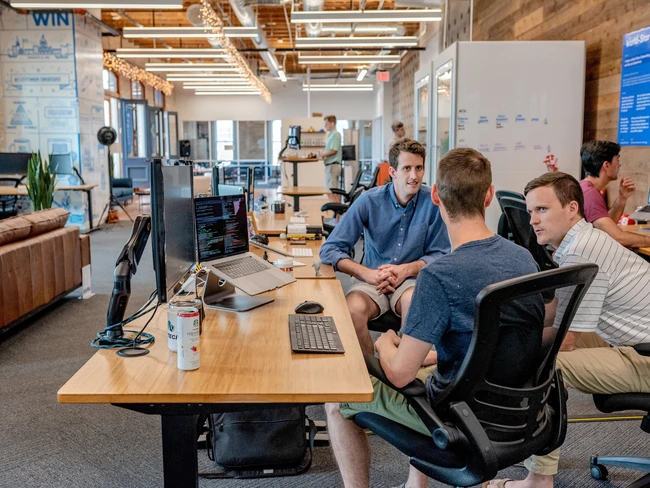
After the last three years, it’s clear that hybrid working isn’t going anywhere. Staff have grown accustomed to choosing how and where they work, and most don’t plan to give that up. Especially when 83 per cent of office workers say they prefer a hybrid model too.[i]
From a leadership perspective, crafting effective policies in a work environment where some employees are in the office, others work remotely, and some do a mix of both, remains a challenge. In fact, new data shows that 33 per cent of UK workers feel that their organisation’s current approach to hybrid work has created greater silos and fragmentation of knowledge between colleagues.[ii]
Failing to provide clarity in this new work landscape is leading to confusion that’s impacting employee performance, morale and more importantly, their well-being. To navigate these challenges, organisations must undergo a comprehensive transformation in how they engage with their colleagues inside the workspace.
The blurred lines of working
In the past, the boundaries between work and home were more clearly defined. Leaving the office meant leaving work behind and entering your own personal space.
Now, remote and hybrid work has blurred these lines, resulting in a constant intertwining of professional and personal life. Having to continuously switch between two workplaces and establish two different daily work habits can lead to both emotional and mental fatigue.[iii] This only leads to employee burnout trying to juggle the two, piling on additional pressure that leads to more stress.
Put simply, we’re in “the great exhaustion” and business leaders are not doing enough. Their silence on the distinct lack of support associated with the future of hybrid work speaks volumes, with nearly two-thirds of organisations not communicating their plans for a hybrid working policy in a post-pandemic working world.[iv] And uncertainty has a detrimental impact on mental health.[v]
So, what can be done to allay these issues?
A culture centred around communication
Managing a hybrid workforce requires a different leadership style based on clarity and communication with a certain nuance and finesse. Those in leadership must now be able to identify the signs when someone is struggling. But identifying the signs is understandably more difficult when half of your team is working remotely at any given time.
The key is in creating an environment where employees feel comfortable expressing their concerns and seeking support when needed. It’s important to foster a culture that encourages open communication and dialogue about mental health and any other challenges in the workplace. Empathising with employees, encouraging connectivity and nurturing trust all reduce the burden of identifying unspoken issues.
Therefore, to lay the foundation for an inclusive hybrid work environment, it’s crucial for organisations to recognise and acknowledge what their staff need. Consider not just the differences in personalities but also circumstances. For example, a parent will have different work-related needs and expectations compared to a colleague who is fresh out of university. But both are equally susceptible to mental and physical health issues when operating in a hybrid work pattern.
So, embracing the needs and the diverse ways of working in a collaborative environment, whilst ensuring open lines of communication for all, will encourage staff to contribute effectively, irrespective of their location.
Leveraging technology for support
The second step is monitoring. But forget monitoring workload and enforcing “presenteeism”[vi] onto staff. Instead, aim to ensure that their needs are catered for. How, you ask?
Through technology.
It plays a pivotal role in supporting staff working in hybrid roles. Utilising digital collaboration tools, resource management platforms and communication applications allow staff to communicate, plan, monitor and even book the space or equipment they need to work.
Case in point, hybrid workers and those “hot-desking” are constantly switching between venues, including the office, and this alone can be detrimental to someone’s productivity or mental health. Setting up their workstation, getting access to equipment, difficulty socialising with co-workers and not having the right space to work can further increase stress. In fact, 58 per cent of UK workers cited the prospect of not knowing where to sit every day as the biggest stressor when it comes to hot desking.[vii]
Leveraging the right technological solutions to monitor how the office space and equipment are being used and being able to book resources when needed will alleviate this anxiety. Especially when 61 per cent felt the ability to pre-book their desk in advance would ease the stress of going into the office.[viii]
Moreover, analysing resource usage patterns and leveraging valuable data-driven insights can help organisations optimise workflows. It can also improve well-being and allocate resources more efficiently, such as introducing wellness programmes, adjusting the office temperature or investing in the right equipment to meet the specific needs of remote and in-office workers.
Better preparing the workspace
Put simply, creating an effective hybrid work policy involves aligning the physical workspace with the flexibility of this dynamic work model, all while building it around the human element of hybrid working. It's time for businesses to reimagine office layouts to cater to the blend of in-office and remote work, using technology to better understand how to manage their resources for the benefit of their staff.
The technology is there. Now, organisations need to review, refine and create new policies and procedures to ensure their model works for everyone so that employees have equitable access to resources, information, and opportunities for professional growth. A one-size-fits-all approach simply won’t cut it in today’s world of work.
[i] Accenture, Future of work research
[iv] McKinsey & Company, The great exhaustion
[v] Valley Oaks, The Impact of Uncertainty on Mental Health
[vi] FranklinCovey, Presenteeism in the Age of Hybrid Working
[vii] The HR Director, What is the link between office space and employee stress?









